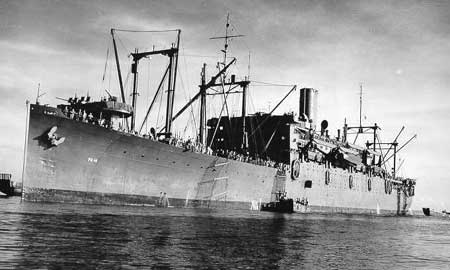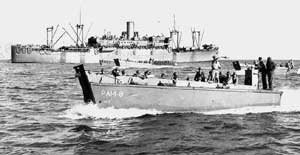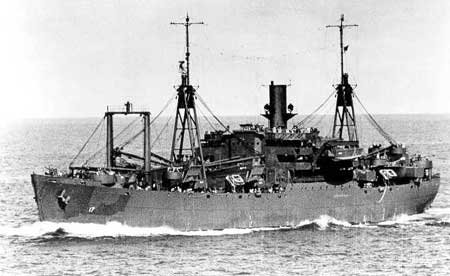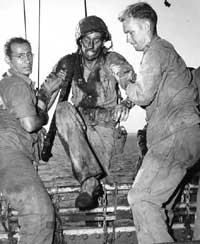| The War in the Pacific |
|
|
The Marshall Islands Throughout the fall of 1943, the Coast Guard actively participated in the Allied drives through the Southwest and Central Pacific. In February 1944, during the Marshall Island Campaign, the Coast Guard once again played an important role. For Operation Flintlock the Allies focused their attention on Kwajalein, Eniwetok, and Majuro atolls within the Marshall Archipelago. The plan called for Majuro Atoll to be taken first to provide an anchorage for the fleet. Kwajalein would be assaulted from both ends the following day, and for Eniwetok Atoll to be attacked about three months later to allow the Allies to consolidate their positions.
Assembled to capture these atolls was the Joint Expeditionary Force comprising nearly 300 vessels and more than 84,000 men. This force split into three groups: a northern group for an attack on Roi and Namur islands in the Kwajalein Atoll, a southern group for an assault on Kwajalein Island 45 miles to the south, and a third group for landings on Majuro Atoll, about 250 miles southeast of Kwajalein Atoll. The flagship for the task force attacking Majuro was the Coast Guard-manned transport Cambria (APA-36). The Majuro force steamed into position to land troops on Jan. 31. Unknown to the Americans, the Japanese left Majuro Atoll in November 1943, and only four Japanese inhabited the islands. On Feb. 1 the task force entered the lagoon uncontested. This atoll would serve as the staging area for Central Pacific fleet operations for the next several months. The Northern Attack Force, including six transports with full or partial Coast Guard crews, gathered to strike at Roi and Namur islands within the Kwajalein Atoll, the largest atoll in the world. They arrived in the Kwajalein area Jan. 30, 1944. The next day the fire-support vessels and aircraft began subjecting the Japanese defenders on Roi and Namur and other nearby islands to an intense bombardment. The barrage killed a large number of the islands' 3,700 defenders. The American combat troops landed Feb. 1, with almost no opposition. All organized resistance from these two islands ceased just shortly after noon the next day. By Feb. 7, with some mopping-up actions, this attack force secured about 55 islands.
On Jan. 30, the Southern Attack Force arrived off Kwajalein. Battleships and cruisers began immediately laying down a devastating bombardment on the enemy defenses. The Coast Guard had four manned or partially-manned transports active in the assault. The landing went so well that the Reserve Group, including five other transports with entire and partial Coast Guard crews, did not even participate. The amphibious forces secured Kwajalein and the nearby islands by the afternoon of Feb. 4. The quick capture of Kwajalein and Majuro atolls allowed the American leaders to advance the date for the capture of Eniwetok Atoll from May 10 to Feb. 17. They now used the Reserve Group and the men that had not been put ashore.
Eniwetok Atoll lies 330 miles northwest of Kwajalein and is the most western island in the Marshall group. The three principal islands defended by the Japanese were Eniwetok, Parry, and Engebi. A task group of 89 vessels assembled, including the Cambria which served as the flagship. The Coast Guard-manned transport Leonard Wood, Centaurus (AKA-17) and Arthur Middleton also participated, along with the partially Coast Guard-manned President Monroe (AP-104), Heywood (AP-12) and Electra (AKA-4). In all, the transports carried nearly 8,000 assault troops. The transports assembled Feb. 15 for the trip to Eniwetok. At Eniwetok Atoll the barrier islands were attacked one at a time. Each in turn was subjected to a heavy and continuous bombardment in preparation for the landings. The first island selected for capture was Engebi. On Feb. 18, the Heywood and Arthur Middleton participated in these landings. One of the Middleton's boats led the first wave to the beach. After the first waves of landing craft reached the beach, the transports moved closer to shore to facilitate the unloading of supplies for the troops. As in the earlier assaults the heavy bombardment killed many of the defenders and the assaulting waves met only light resistance. On the 19th, while the Engebi landings proceeded, the transports prepared to land troops on Eniwetok, and by Feb. 21 they had secured the island. Parry Island was more strongly held than anticipated, therefore the landings were postponed until D-day plus 5 - Feb. 22. The naval forces subjected the island to gunfire for four days. Nevertheless, some defenders survived and the first wave met enemy rifle and mortar fire. The attacking forces quickly overcame the Japanese and secured Parry Island 12 hours after the initial landings. |



